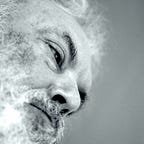Honor the Onion
Pierre’s Stoic Vegetarian Cuisine
Honoring the Onion is a metaphor!
It stands for a cuisine that excels by its simplicity: ordinary and inexpensive ingredients, short preparation time, freshness and quality, fusion of culinary smart, spontaneity and intuition.
Both in the East and the West, onions and garlic have been rated as primers for good health, as they contribute, inter alia, to good blood circulation. In China, back in ancient times, onions and garlic were used as healing agents and for medical concoctions. There is an ancient 1500-pages manual that lists all the diseases that can be healed with garlic alone. In the West, too, Paracelsus advocated healing with onions and garlic.
Anatomically, as you see in the graphics above, the onion looks like a nested network. We know from systems theory today that life consists not of hierarchies but of networks within networks, a horizontal structure. In addition, the golden proportions can be made out in every onion. It’s a perfect piece of Divine symmetry and proportionality.
We humans are like onions, we consist of many layers. Layer after layer peeled off, we gain more in substance, more in spiritual strength, more in wisdom.
Spiritual development thus is nothing but peeling our onion skins … in order to gain ever more perfection … and this is the ultimate metaphor for the science of cookery: it’s ultimately a spiritual quest of its finest!
I started photography at the age of 9 with a Kodak Instamatic, at age 16, with videography. After my long years of studying law, philosophy and psychology did not leave me time for pursuing my interest in photography. It was only in 1985, when I was thirty years old that I could buy a good camera, the Minolta 300. The kit 35–70 mm zoom kit lens was excellent and the camera overall as well. I photographed with this camera, inter alia, these two collections about the Acropolis, and Aegina island, in 1986.
My first digital photo and video camcorder, bought in 2000, was the Sony VX-2000, which I was very happy with for seven years. I photographed with this camera my food photos 2002–2004 in the Provence, and I owned it from 2000 to 2007.
See Collection on Flickr (Culinary Provence, 261 Photos)
In 2007 I bought the Canon EOS 400D and was very satisfied with it, while the kit lens was from cheap plastic, yet the photos were amazing despite all, and even more so, the absence of grain even at high ISO — which I later found is one of the great pluses of all Canon cameras.
I sold the camera in 2011 for acquiring the absolutely marvelous Canon 5D Mark II which was quite an investment with four lenses, a Canon Speedlight 580EX II flash, as well as a Manfrotto tripod and an LCD monitor for video shooting.
Stoic cuisine, what does that mean? It certainly means a lot to a lot of people, but it also means health — namely in accordance with the oldest of traditions for which food was always also medicine. That in turn means that eating the right food keeps you healthy! That is the basic message, while of course, handling your emotions also plays a major part in your health, for the body responds favorably to vibrotherapeutics.
But on the simple physical level, it matters what you eat, and how you eat what you eat. Both what you eat and how you eat it are matters of culinary culture. But I will treat them on different pages, simply for reasons of functional design. Most people may be less interested in knowing what culinary culture means in respect to how to eat … and they may come up with quick excuses, such as lacking time for proper eating habits, and so on and so forth.
They may however be more interested what to eat in order to prevent some major illnesses such as gout /arthritis, but even a common cold without resorting to medical ‘bullet’ medicine.
